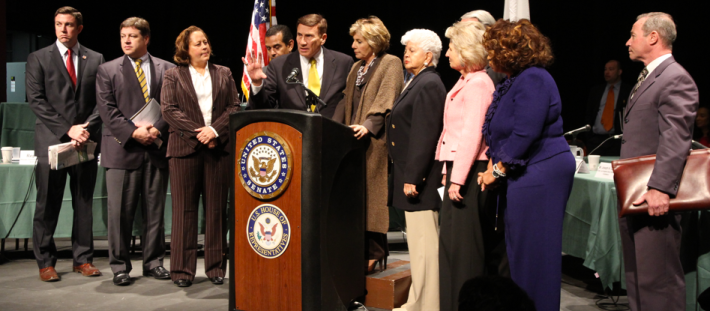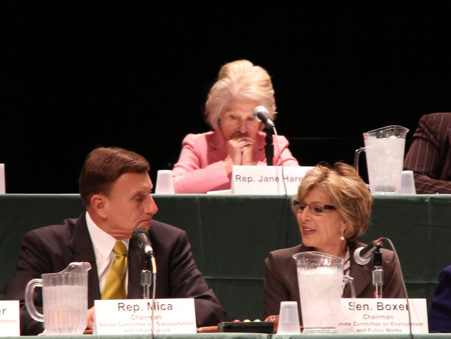Goodbye, 30/10. Hello, Fast Forward America.
3:43 PM PST on February 23, 2011

Goodbye "30/10" and hello "Fast Forward America."
Congressman John Mica (R-FL) and Senator Barbara Boxer (D-CA) brought their road show to Los Angeles earlier this morning to get feedback and elicit testimony on how to improve the federal transportation bill. While Boxer was on her "home turf," it was Mica who sounded like a local finding time to complain about traffic, needle Los Angeles Mayor Antonio Villaraigosa about transit connections to LAX and repeatedly honor Rep. Jane Harman (D-CA) who was attending her last public event as a Member of Congress.
While there was some talk of the need to better move freight through the Southland, much of the conversation was dominated by ways to expedite project delivery of all sorts. There was no talk of America's obesity epidemic, rebuilding our cities and communities or even a mention of the words "bicycle' or "pedestrian." The focus was almost completely on transit and goods movement.
Back in 2008, as soon as Los Angeles County passed a half cent sales tax dedicated towards expanding it's transportation network, the question was asked, "when are we going to start seeing projects on the ground." Thanks to some innovations from the Move L.A. Coalition and the support of the Los Angeles Mayor's office, the 30/10 Initiative was born. The plan was to leverage the funds that would be collected over the thirty year sales tax to build the transit projects within the next ten years. By borrowing the money from the federal government up front, projects would be delivered sooner, taking advantage of today's low construction costs and creating 160,000 construction jobs when the industry needs it most.
Because the plan would require some changes to federal law, there had always been some discussion of how these changes would help communities outside of Southern California. Today, Los Angeles Mayor Antonio Villaraigosa re-branded the 30/10 Initiative as a national initiative focused on putting more construction workers to work on more projects through "America Fast Forward."
America Fast Forward is a program that would leverage the funds created through local sales and gas taxes dedicated for transportation with low interest federal loans to jump start projects that already have "49%" of the project paid for at the local level. The program has received the support of the U.S. Chamber of Commerce, the AFL-CIO, and over 60 mayors from around the country. In his testimony, Villaraigosa described the changes in federal transportation financing that would make America Fast Forward possible. In particular, he called for the expansion of the Transportation and Infrastructure Finance and Innovation Act (TIFIA).
Villraigosa called for nearly tripling the TIFIA Budget to at least $350 million annually. Later in the hearing, Boxer commented that even the $350 million number was low, prompting Villaraigosa to say that he would support as high a number as he could get. American Fast Forward also calls for:
- Increasing the maximum percentage of the project allotment that TIFIA can fund. Currently, TIFIA will fund up to 80% of a project with no "added points" going towards proposal with a higher local match. Villaraigosa called for at least a 49% local match;
- Permitting the U.S. Department of Transportation (USDOT) to approve multiple related projects at the same time. In Los Angeles County, for example, this could mean loans for the entire suite of Measure R transit projects at once, as opposed to a line-by-line piecemeal approach;
- Allowing USDOT to grant up-front credits to projects and;
- Authorizing USDOT to lock-in interest rates for approved projects.
"This is not an earmark, it is a template," finished Villaraigosa, who noted throughout his presentation that this model would help the communities that have voted to help themselves.
Don Knabe, the Board Chair for the Los Angeles County Metropolitan Transit Authority (Metro), made the case that federal investment in communities that invest in themselves is a long-overdue idea. "Every time we go to Washington, the feds tell us to come back with a funding source. The voters of this county have voted to tax themselves three times in the last three decades. Yet, we are not awarded for the leadership that this agency has shown nor the leadership our voters have shown."
Also backing Villaraigosa and Knabe were key representatives of business and labor, respectively, Mr. Joseph A. Czyzyk, Chair of the Los Angeles Area Chamber of Commerce, and Mr. Robbie Hunter, Council Representative, Los Angeles/Orange Counties Building & Construction Trades Council.
Across the "Orange Curtain" they have a different program to speed up project delivery. Will Kempton, now the Director of the Orange County Transit Authority outlined their program for project expedition, the "Breaking Down Barriers Initiative." While Kempton promised a written testimony that would cover two dozen suggestions, for today's hearing he outlined four needs to bring projects to fruition more quickly.
- Extend and expand National Environmental Protection Act delegation to states, allowing those with strong environmental regulation to do their own environmental reviews only once, instead of an additional parallel federal review.
- Streamline the federal funding process.
- Overlap activities that can be overlapped.
- Work with the environmental community to streamline permitting.
Of these, expanding the "NEPA Delegation Pilot Program" seems the most promising. Because California's environmental review law, CEQA, is more stringent than NEPA, California can grant both CEQA and NEPA permits at the same time. Kempton estimated this cuts between 10 and 14 months off the delivery time for a project.
Much of the discussion on freight was about how to move freight more efficiently. Both Knabe and Congresswoman Laura Richardson represent the areas surrounding the Ports of Los Angeles and Long Beach, and both were looking for answers on ways to move freight better. Kathryn Phillips, from the Environmental Defense Fund, congratulated the Ports on their clean air initiatives. However, no panelists offered specific proposals for how to move freight through Los Angeles better. That said, Rep. Bill Shuster (R-Penn.) noted that 40 percent of goods that arrive through L.A.'s ports end up east of the Mississippi River, so goods movement in Los Angeles should be a national priority.
As touched on earlier, the complete lack of any discussion about urban mobility in the form of creating better communities, creating walkable and bikeable streets and just encouraging options to the automobile was jarring. Los Angeles is in the early stages of a Livable Streets renaissance, with a progressive bike plan and news of the My Figueroa project dominating the local Streetsblog in 2011. The only thing that L.A. needs is a true funding commitment to create sustainable urban communities, but today talk of that commitment was nowhere to be found.
Stay in touch
Sign up for our free newsletter
More from Streetsblog Los Angeles
Metro Board Funds Free Student Transit Pass Program through July 2025
Metro student free passes funded another year - plus other updates from today's Metro board meeting
Eyes on the Street: New Lincoln Park Avenue Bike Lanes
The recently installed 1.25-mile long bikeway spans Lincoln Park Avenue, Flora Avenue, and Sierra Street - it's arguably the first new bike facility of the Measure HLA era





